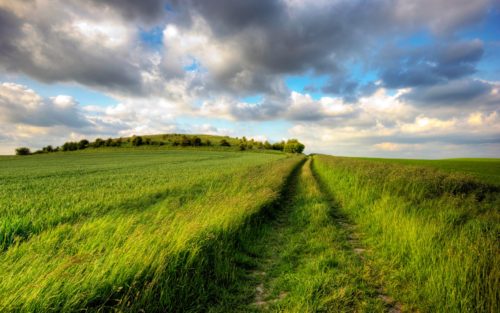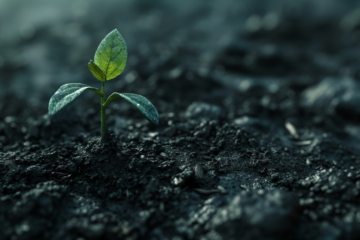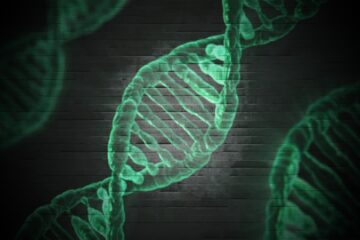All Flesh is Grass
by Peter Goodchild
IN ORDER to be fully human, I occasionally need to put my hands on the green things that grow on the surface of this planet, because those leaves and I are one. My personal loss is proportional to my ability to destroy that unity. “All flesh is grass.” This is the essential fact of human life, physically speaking. The prophet Isaiah meant that human life is ephemeral, that it fades like the grass. Whenever those words have occurred to me, however, I have taken them out of context and had thoughts that are roughly the converse. If I walk across a vacant lot in the middle of the city, I see great squares of concrete, symmetrical ledges with worm-like rods of rusted iron, and among all of it the grass is growing. A thousand years from now, the iron will have rusted away, the concrete will have dissolved, and the grass that grows there today will have seeded and reseeded itself. As a cool north wind blows soft clouds across the sky, countless blades of grass will be bending and rising in that breeze, beaten and brushed, rotting in winter, sparkling yellow-green in spring. Grass was growing on the earth long before human beings evolved, and I suspect that it will be growing there long after we are gone.
Grasses are the least of things to look at. Even among the few urbanites who are still nature lovers, although birds and fish and roses and maple trees may be regarded as beautiful to behold, I have never met anyone who has deliberately sat in bed late at night reading the first volume of Britton and Brown’s Illustrated Flora, a volume largely devoted to the Gramineae, the grasses. Perhaps it took many years of living for me to reach that stage, or perhaps the poet in me is giving way to the scientist, as happened to Thoreau in his later years. Grasses, like olives, are something for which we may have to acquire a fondness only slowly. They seem to lack beauty: their flowers are so small and undistinguished in color that for most people they do not exist. In fact, for a large part of a grass’s life the plant is quite brown, so that it seems to be either dead or at least unhealthy; yet that brown dormancy is part of the essential cycle.
I have friends for whom anything green is an impediment. Naturally occurring vegetation is a sign of property in need of cement, and trees are God’s way of telling us to buy chain saws. Sometimes I feel that it is my duty to explain to them that there are nearly half a million species of plants on earth, and each one contains a universe of its own. No matter how narrowly we focus our attention, the stars and galaxies expand in our gaze. And so it happened that after many years of looking at grasses I realized that they are not all alike. Even in Ontario, a northern land where the fauna and flora are therefore less numerous than elsewhere, I could not walk in my own suburban backyard without encountering a dozen species of grass. I am quite aware of the diversity: I once bought a hundred-year-old house, and the first summer was spent disturbing this populous tenth of an acre, day after day, until the neighbors said, “Oh, what a nice garden you have.” Nice, yes, perhaps, but in the long struggle I gained an admiration for my competitors, the vegetation that was here before me.
The more I look, the more I see entrancing variety in the “dull” grasses that grow at my feet. Witch grass, if allowed to grow to its full size, has a flowering head as rich and full as the tail of an ostrich. The common bluegrass that grows in the lawn has blades that are shaped, at the tip, like the bows of tiny boats. Foxtail has compact heads with grains that make the plant look like a kind of miniature wheat. Barnyard grass, one of my favorite weeds, has flowering heads with grains large enough that the plant was cultivated, thousands of years ago, by the native people of what is now the southwestern United States. Squirreltail grass, with its long fine “fur,” belongs to the same genus as cultivated barley.
Human life would be impossible without grasses. Wheat, rice, barley, corn, sorghum, millet, oats, rye — these are the foods we eat every day, and it is these or other grasses that we feed to the animals we kill as other food. A diet of lettuce and tomatoes would be slow starvation: it is the bread on our plates, the rice in our bowls, that supply the thousands of calories that keep us alive. One of my common thoughts is of the end of the present world, a day that might arrive after any of a dozen military or economic preludes, and I imagine an isolated survivor wandering through a twisted and shattered variety store. The writing on the label is still legible: “Yummy Pudding / Only five calories in every serving!” As the grass takes over, the survivors of the Apocalypse will not intentionally regard “diet” as synonymous with “weight reduction.”
One year I grew a tiny plot of wheat at the west end of my property, beside the garage. I knew so little about this plant that I felt, every day, like a baby who could not walk or talk, let alone read a book or drive a car. On odd occasions over the years, I had browsed some of the largest libraries in North America, looking for books on raising grains in large quantities and without modern equipment and chemicals. After all my searching, I found only one book, and I could not buy a copy because it was out of print. Perhaps some government agency, concerned with aid to impoverished countries, might have a manual with this data, but I could not track down either the bureaucracy or the manual. And yet without such written information, I make so many mistakes, and I had to guess so much. What kind of grain should I grow? How do I prepare the land before sowing? How do I sow the seed? How thickly do I sow? What do I do after the grain is in the ground? How do I control weeds? What stages does the grain go through as it grows, and in what months should I expect to observe these stages?
I knew almost nothing about the subject, although I knew more than anyone else in that neighborhood. That very lack of knowledge was an indicator of how much we humans have lost touch with the natural world. I knew that it was the Gramineae that stand between humanity and starvation, as they have for thousands of years. But I knew only the basic facts about how to grow a stalk of wheat, cut it down, thresh the grains from the stalk, dry the grain, grind it into flour, and bake a loaf of bread. What if, one day, I was that lonely survivor, stumbling across a metropolitan graveyard, who reached down among the rubble and came up with that can of Yummy Pudding? How would I begin to make up the difference? How would I atone for the ignorance of my generation?
As the years go by, I approach a modest wealth, in the financial sense of the word. I may be suffering from “information overload,” I may be “stressed out,” “burned out,” caught in an endless process of trying to eliminate the inessentials and finding those “time slots” immediately filled with tasks that bear an uncanny resemblance to the ones that I have just eliminated. I may find (as I did once) that I arrive at business meetings with my mind so numbed with “data” that I have lost my umbrella and brought the wrong papers. But I can take comfort in the fact that I will have enough money to cover my premature (Type A) funeral. As Wordsworth said, “Getting and spending, we lay waste our powers: / Little we see in Nature that is ours.”
And it is for that reason that I draw attention to the least of the flora of this planet. I do not believe that to appease the hunger of the body is to appease the hunger of the soul, but I do believe in appeasing something in between: the hunger of the eye. In spite of the madness of my daily life, there must, at least, be times when I can take a long drive out of this city. The city is eating me up. I have made a bad bargain, and I have lost my soul. I have become a success, and because of that I am a failure. I open a magazine and see a photograph of a wealthy executive, with his white shirt, his necktie, his gray suit, and his unreal life. I realize that with a little more effort I could have my own photograph in that magazine, and the thought is horrifying. So I must drive past the shopping centers, past the gardening centers, past all the other centers (how lucky we are, that wherever we go we are at the center!), until the “roads to” become “roads at,” until becoming is replaced by being. The sounds of the city are replaced by the sounds of the country. I hear the long note of the red-winged blackbird as he perches on a cattail stalk. I park the car, and, like heraldic trumpeters, a hundred geese pass overhead, far above me. I want to go where they are going, and where they are going is right here, right among the weeds and the water, the sky and the clouds, brother sun and sister moon. My foot drops as I descend into the damp grasses at the riverside, Phalaris arundinacea, seven feet high, reed canary grass, like thick dark wheat, but a kind never sown by humans. This is reality, this is truth, this is love and beauty and freedom. There is a center to my life, and it is here, here where black willow and level cattail marshes, where boulders the size of my living room lie, and roads of golden gravel where wild mushrooms grow among the raspberry tangles. If I meet a human being here, it is a moment of tension, of embarrassment. (“Are you one of them? A nature lover? How shocking! As for me, I was only taking my dog for a walk.”), and yet why is there such pleasure in saying hello to a stranger in such circumstances? I would certainly never say hello to a stranger downtown.
The danger is over: the human and the dog walk by. I wander off the road and down to the grasses again, to where the bank drops into the river. The water circles and sways, dry leaves dance in the whirlpools, the faraway red-wing again sings his metallic “toe-ga-lay,” and the grass shakes its long, long arms. The grass, taller than I, whispers loudly as I walk through it, as I breathe its bread-like fragrance, as its long brushes sweep my body. How much have I lost? How much have I gained? And yet, how short my life is. All flesh is grass.
* * *
Source: How Should We Live?







This is an incredibly beautiful, poetic piece of writing. It evokes the essentially Cosmotheist view of Nature which lies — sometimes slumbering, sometimes fully awakened — in the spirit of European Man. Thank you Mr. Goodchild.
1-6-21 is an amazing time to live! Starting the 2nd year of society and civilization coping with Covid — and appreciating life all the more. And yes – Mr. Goodchild’s piece is also amazingly invigorating!
I just hope you believe ALL of the Good Book and accept the supernatural information in it. If you have not specifically surrendered your life to Jesus Christ, please do so NOW and enjoy His creation, confident of your own ETERNITY! John 3:16-17; Romans 10:9-10; and that WHOLE CHAPTER of I Peter 1, especially v.9.
May God bless us, every one!